We woke up at 6:15 a.m. We took showers and went to breakfast at 8:15. My stomach was still bothering me,
so I only had some bread (the kind shaped like a silkworm) and tea. Craig had fried eggs, dumplings, bread, potatoes with peppers, and watermelon.
We stopped back at the room and met Wang
Jun and Mr. Zhou in the lobby at 9 o'clock. Over the course of our drive to Lang De Village. Wang Jun explained the origins and ramifications of the One Child Policy:
Japan invaded China in 1937, and warred with the Chinese until 1945. They attacked villages, killing all inhabitants and livestock. After that, there was a 4 year civil war between the two Chinese political parties. In the wake of these conflicts, the Chinese population was down to around 400 million. In 1949, Chairman Mao encouraged more births to replenish the population. A woman who had more than 4 children was named a "Mother Hero," and was considered a national treasure.
The population almost doubled in 20 years to 800 million. Anthropologists and scholars warned of the problems this could create, but Mao didn't want to hear it and threw them in jail.
When Chairman Mao died in 1976 he was succeeded by Deng Xiao Ping, who encouraged reforms. He was not a hardline socialist and admitted that capitalism had its virtues as well. He instituted the one couple / one child policy. There were a few exceptions (a couple who had a disabled child could apply for the right to have a second child, minority groups were allowed additional children after 3 years, Tibetans could have an unrestricted number of children), but for most people, more than one baby meant harsh sanctions. People could lose their job, face excessive taxation, etc.
For all of the human rights ramifications ("human rights, da da da..." as Wang Jun described it), scholars say that without the One Child Policy, China would have arrived at its current population of 1.5 billion people 15 years earlier.
China has only 7% of the world's farmland and 25% of its population, but is now capable of feeding the entire country. They don't need to import any food. Lifespan has increased, but this is now a problem as there aren't enough young people to look after their elders. Each only child has 2 parents and 4 grandparents who have no other descendants. Obviously more reforms are needed to keep the population sustainable. In 2013, the policy was changed so that if one parent is an only child, the couple can have 2 children.
In rural areas, male babies are preferred because they can work in the fields. Abortion is legal, but infanticide of girls was a big problem. You can go to jail if caught. So many girls have been abandoned, and this led to a large number of overseas adoptions.
In cities, female babies are often preferred. Boys need to provide a house in order to get married. Real estate is expensive in cities, so parents spend all of their savings on buying a house for their son. For this reason boys are nicknamed "construction banks" and girls are nicknamed "merchant banks."
An hour into this fascinating conversation, we arrived in Lang De Village, a gorgeous, historic village of the Long Skirt Miao. Their traditional dress is skirts made from vertical strips of elaborately embroidered fabric. They wear silver ornamentation, including elaborate headdresses and necklaces. (They sell silverwork today which is actually an alloy). Their embroidery expertise is in knot stitch and double needle stitch (one needle from above and one from below).
This village was founded in the 14th century. The oldest house standing today is 200 years old. In the olden days, the traditional houses were built out of fir planks using no nails. This was the first Chinese ethnic minority village to open to western tourism back in 1980. It was also one of only two places in Guizhou to host the Olympic torch relay in 2008.
Today, the government insists that residents keep their houses in the traditional style. Even if they now use some modern materials for infrastructure, the exterior must look traditional, using fir planks for siding and fir bark for shingles. The government and tourism bureau are also responsible for some inauthentic architecture on the site: namely a wind and rain bridge. While beautiful, this is an architectural style of the Dong people, not the Miao who love here. Wang Jun didn't even want us to look at it let alone photograph it, as he ensured us that we would see authentic examples later in the trip.
We wandered around the narrow labyrinthine streets of the village. Along the way, we saw horses, mules, cats, dogs, and birds. In fact, two cats snoozing on a little wooden footbridge reminded us very much of our Inca and Maya back home! Wang Jun led us around and then gave us 20 minutes to explore on our own. Lots of houses have
woven rice sifters with red Chinese characters painted on them. This indicates that they are a homestay. People from the city
(inluding sometimes Wang Jun and his family) come out here to stay for a weekend in the countryside. They can pick their own food from the
villagers' gardens, and pay for what they eat.
Every 12 years, they have a large festival. There is a pole in the center of the festival grounds with slots in the side. Knives are stuck in and people climb the blades in bare feet. They also walk on red hot metal as a sacrifice to their ancestors. They plant fir trees when boys are born, and then 16 years later, they are ready to harvest and to be used to build the boy's house (the "construction bank" notion that Wang Jun explained earlier). We saw waterwheels and people drying rice in the riverbed.
We visited the house of their hometown hero, Yang DaLu, who led an 18-year rebellion against the Qing Dynasty. He had to be killed far away from the village so that
the long skirt Miao wouldn't take retribution on the officals who executed him. His house has been restored and is filled with artifacts.
We reconnected with Wang Jun and walked back to the van to meet Mr. Zhou. As we left, large trucks were delivering coal to the village.
We drove 30 minutes back towards Kaili. We pulled in to a new hot pot restaurant that Wang Jun was interested to check out. He gave us the option
of eating the hot pot here or going somewhere else to have plate dishes similar to what we have been eating. Because my stomach was still not feeling well, I wanted to be
able to pick and choose what to eat, so we opted for dishes rather than a single hot pot. So we drove to their usual stop in this area: Rui Chun Restaurant,
which has more variety. We were once again seated in the front window and gained considerable attention from passersby on the street.
We tried a local specalty: bacon served with a purple root that has the consistency of a gum drop. Wang Jun ordered pumpkin soup for my stomach,
as well as greens, rice, salted pork with greens, and fungi. Craig had a Snow beer. A young man at the next table knew a little English and asked
if he could get a photo with us. He sat between us with his arms around us. Out the window, we could see a cage with birds that I thought must be
pheasants. I asked Wang Jun about it and he said that they were indeed pheasants, and that they were for food. "If it flies, we eat anything,
except mosquitoes. If it has 4 legs, we eat it, exceot for stools." He cracks us up.
As we were leaving the restaurant, I went next door to photograph the pheasants. They were gorgeous, with all different colored iridescent feathers.
I have seen them crossing the street on my commute to work back home.
Next, we went around the corner to Xu's Embroidery Boutique, where we met Mrs. Yong, an embroidery expert who has a very impresive
collection of embroidery from all of the local ethnic minorities. She knows how to do many of the stitches herself. She doesn't speak English, but she
gave us a fascinating lecture and demonstration which Wang Jun translated for us. She has four rooms of embroidered pieces in this boutique, and this is only 10% of her
entire collection. She also sells pieces and is saving money to start a museum to house, preserve, and share her entire collection.
She plans to open it within the next year.
She demonstrated some techniques and showed us some of her prized collection, which includes many different styles and techniques.
Horse hair is embroidered around the perimeter of certain pieces. The Miao in Jianhe County practice tin embroidery, where they incorporate 0.1 mm thick tin foil into their indigo textiles.
Mrs. Yong showed us a jacket that was so vauable that one brother inherited the family house, and the other inherited the jacket!
Mrs. Yong has the contract they drew up to split the property, and she showed us both the jacket and the contract. The piece depicts a little boy in a temple because a lot of
children in the family had died and they were hoping that the next one would be healthy.
Her most prized piece is a
200-year-old jacket made with the thread splitting embroidery technique. One strand of silk thread is split into 13 separate strands to create very elaborate motifs. It was amazing!
We purchased a vibrant 70-year-old piece depicting fuschia-colored Chinese lions. The piece was dyed with
natural pigments and was mounted onto cotton. This cotton had beem soaked in pig's blood and then egg whites to make it stiff and strong, and it has an oily black coloration. It was a very fascinating visit, and we were happy that Wang Jun is acquainted with Mrs. Yong, and was able to coordinate a visit into our itinerary!
We drove back to the hotel. Wang Jun suggested that I may want to try Chinese medicine for my stomach problems. He took us to the local
pharmacy several doors down from the hotel. I bought packet of 10 little glass bottles of an herbal remedy for only 13 yuan ($2). He warned
that it has a very strong taste and that most westerners don't like it, but that it is very effective. I just wanted my stomach to feel
better so that I could enjoy the rest of the trip and get back to eating the deliicious food, so I was up for it.
We went back to the room. You can't take the medicine on an empty stomach, and you have to shake it for 10 seconds. Then you puncture the metal
foil cap with a little plastic tool that is enclosed in the package. You insert a little plastic straw (also included) and drink the contents of
a bottle, and then don't drink anything else for 10 minutes. It actually didn't taste bad at all. It tasted like a strong Ricola, but it tasted
very natural. My stomach started to feel better almost immediately. We had three hours to relax, so I typed up some notes and we watched some
Chinese TV for fun. We watched a show about pandas and then a "Wipeout"-style obstacle course Chinese game show, which was quite entertaining.
We met the guys in the lobby at 6:30. We walked a short ways to a restaurant that Wang Jun had wanted to visit last night, but there haad been
no tables available. Tonight we were the only ones here. The difference between Sunday night and Monday night, I guess. The proprietor gave us
some special tea from his secret stash (hidden behind some liquor bottles at the bar). We had tang yuan dumplings filled with a black liquid which was
made of black sesame powder, sunflower seed powder, peanut powder and sugar - delicious! They were garnished with Chinese pickled cabbage.
We also had shoestring potatoes, beef with bell peppers, corn with cashews, and reduced pork with chilies.
The proprietor was a large man,
and he reminded me of the Godfather. He sat at a large table next to ours, and employees came to him to make change and he would peel bills off
a wad of cash from his pocket. He would go to the window and survey the street, and he was certainly in control of everything. There was a whimsical indoor rock garden next to a seafood tank on the walk to the restroom.
The food was delicious so I was glad that my stomach was better and my appetite was back! Craig had a beer. Mr. Zhou and Wang Jun were
very impressed by the amount and hotness of the chilies that Craig ate. Wang Jun said that in 19 years of guiding, he had never had a tourist
who could eat so many chilies. Mr. Zhou had asked Wang Jun if Craig was Mexican since he eats such hot food. Mr. Zhou took pictures of
Craig eating hot peppers with sweat dripping down the back of his neck. They said that they will remember Craig forever.
Since Craig and I knew how to get back to the hotel and were quite comfortable in the square at night, Wang Jun and Mr. Zhou headed back to the hotel to get some rest at 7:45.
We left shortly after 8 o'clock. We went down into the tunnel under the square and found a shopping mall down there. We went into a department
store, and as we entered, we heard "The Weight" by the Band! We browsed around and then went to a toy store and bought some gifts for our godchildren. The woman offered us a discount because we bought 4 things, and the prices were quite reasonable to begin with. It was very sweet of her. We assume not many westerners frequent these shops.
We went back up to street level and hung out in the square. It was much less busy than on the weekend, but people were still doing all of
the same activities: ballroom dancing, group exercises to music, driving miniature vehicles, etc. We saw twin babies in a stroller and they both waved and babbled to us. Their mom let us get a picture and when I
showed it to the babies, they both reached out for the camera. They were so cute! Other babies were smiling at us and one mom had her toddler
boy blow us a kiss. Everyone is so frendly and we absolutely love interacting with them.
We came back to the room at around 9:30, as the activity in the square was winding down for the night. Somebody rang our doorbell at
10:50, but when I answered it, there was nobody there. We went to bed after downloading photos and writing in the journal. I took
another dose of the herbal stomach remedy just before bed, just to be on the safe side.
Lang De Village
|
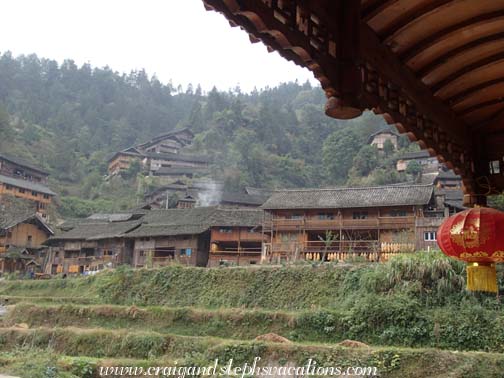
Lang De Village
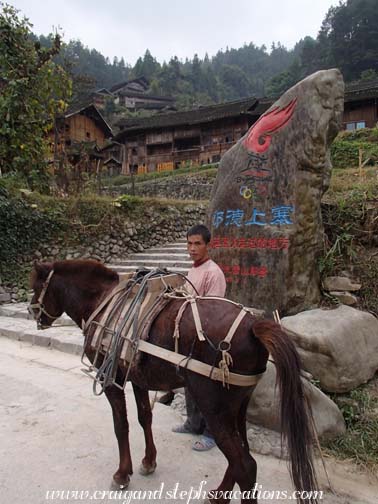
Lang De Village - stone comemorates that the Olympic Torch came here in 2008
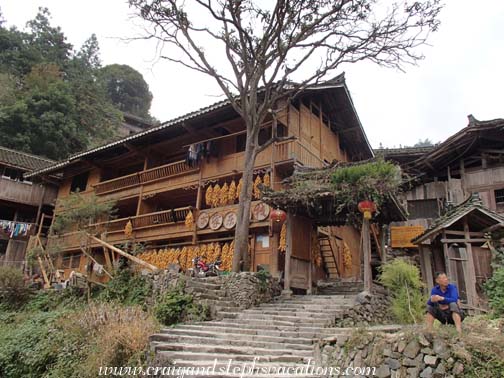
Lang De Village homestay
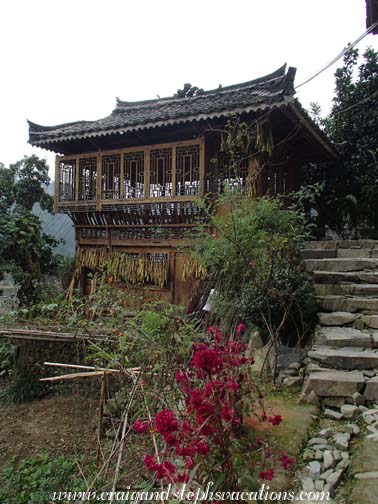
Lang De Village
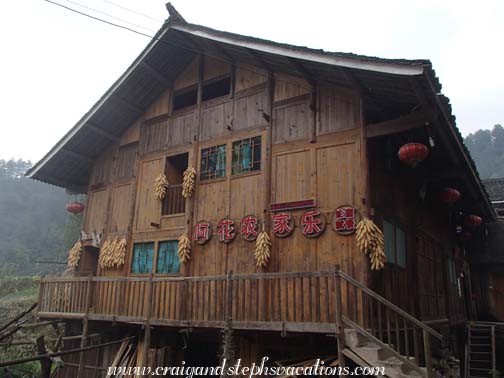
Lang De Village homestay
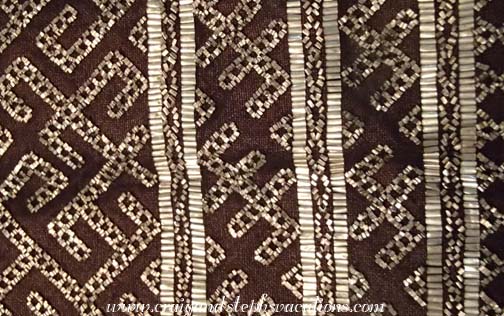
Tin embroidery at Mrs. Yong's
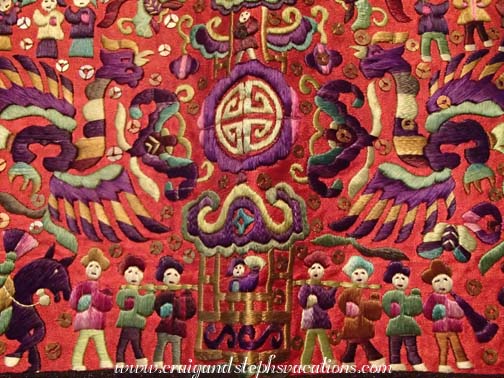
200-year-old example of thread-splitting embroidery at Mrs. Yong's, splitting a single silk thread into 13 strands
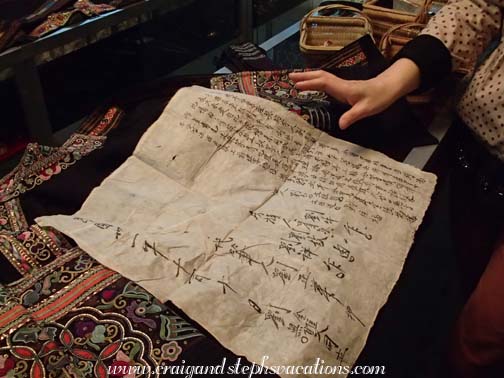
Valuable embroidered jacket and the paperwork for its inheritance at Mrs. Yong's
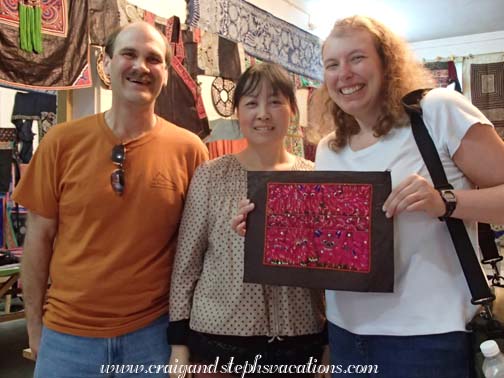
Our purchase from Mrs. Yong
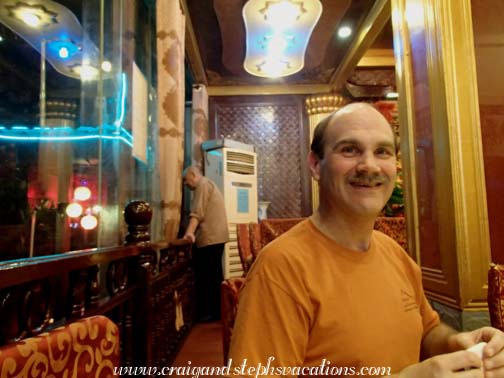
Dinner with the proprietor in the background
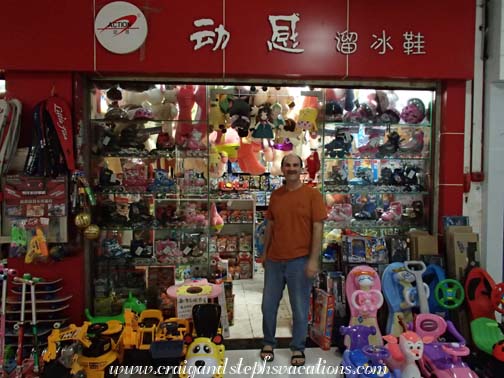
Subterranean toy store

|






